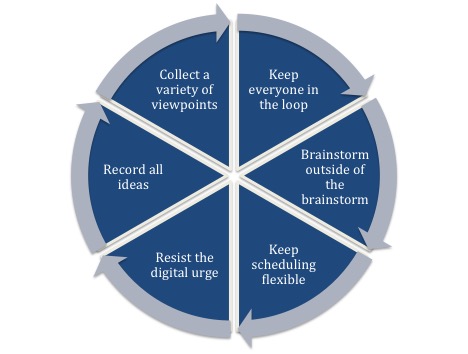Brainstorms allow an office to come together to create brilliant work or creative solutions. However, sometimes brainstorming can feel unproductive – people shouting out any idea that comes to mind or, quite the opposite, it can feel like only two people are contributing while the rest are sitting quietly or focusing elsewhere. Where is the middle line? How can you facilitate a successful brainstorming session? How can you effectively brainstorm business ideas? How can a brainstorm optimize creativity and inspiration in the most effective ways? Here are six creative brainstorming techniques that will improve your employee brainstorm sessions:
1. Keep everyone in the loop
Letting everyone in on the boundaries of the project weeds out ideas that may be great, but not realistic. When you facilitate a brainstorm, let everyone know limitations such as budget, timing, resources, etc. to allow for ideas that are practical to implement.
2. Brainstorm outside of the brainstorm
It sounds strange at first, but not everyone can brainstorm on a schedule. It is a good idea to have a 10-minute introduction to what is needed and the limitations, then allow people to disperse. Regroup again later to review all of the ideas. This creative brainstorming technique allows for concepts to be fully developed prior to the meeting so it will save time discussing ideas that may not be feasible.
3. Keep scheduling flexible
Sometimes you need fresh ideas ASAP and have to call the masses for immediate help, which is understandable and happens often. However, when you do know ahead of time that you will need new concepts and you have a few different times available to schedule it, provide your co-workers with options. Account staff generally will stop what they are doing and go to a scheduled meeting with no problems, but it may be harder for designers to walk away mid-project. If you are facilitating the brainstorming session, we recommend that you give a couple time options that fit with your schedule and then choose the one that the majority of employees can attend.
“Inspiration doesn’t respond to meeting requests. You can’t schedule greatness.” – Jay Baer
4. Resist the digital urge
Research shows that the best ideas come at the beginning of a brainstorm. This is when you’ll want everyone to be most attentive and want them to contribute. In this busy industry, many of us are still answering emails and doing research while in other meetings, this doesn’t allow for complete focus and creativity. Make it a habit that the first 15 minutes of each brainstorm are spent without electronic devices to get the most creativity out of your participants.
5. Record all ideas
Brainstorm ideas can get diluted because people may see the aspects that make an idea challenging rather than successful – mostly this is due to over analyzing. Even if you shoot down an idea, still have the note taker record it (if you don’t have a note taker – you should). You may find later on that an idea fits better than you originally thought, or that there is a variation that can make it more practical. Try to choose a note taker that can both keep up with and organize your quickly moving thoughts. (Your note taker can be exempt from the “resist the digital” rule, of course.
6. Collect a variety of viewpoints
The outsider perspective is often the most important perspective. Invite a staff member who is working on a different client or who has different interests than those already invited. Diversity can, not only spark new ideas, but can work expand on current ideas to make them greater. For example, if everyone in the meeting is over 45, invite the 21 year old – he/she will see a different view and have a valuable input.

Does your office already practice some or all of these creative brainstorming techniques? Let us know what you find most successful and where you need more improvement. If you don’t do any of these for brainstorms right now, try implementing a couple at a time. Change is sometimes hard, so let your employees know that you’ll be transitioning and try a couple techniques at a time and ask for feedback, let your employees tell you what is and isn’t working.
Want to talk about brainstorms? We’d love to. Shoot us an email or give us a call at 314-727-5850 and let’s discuss the ins and outs of group brainpower.